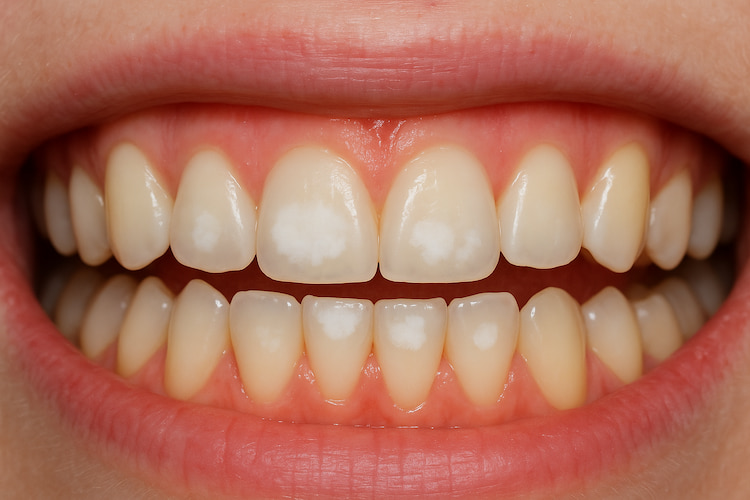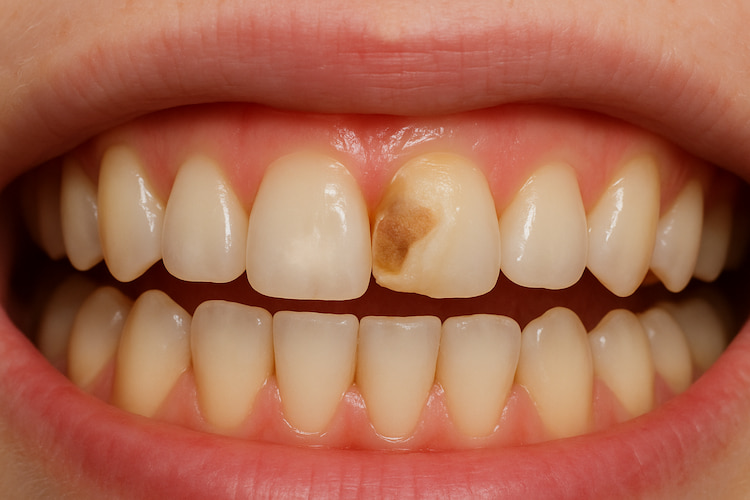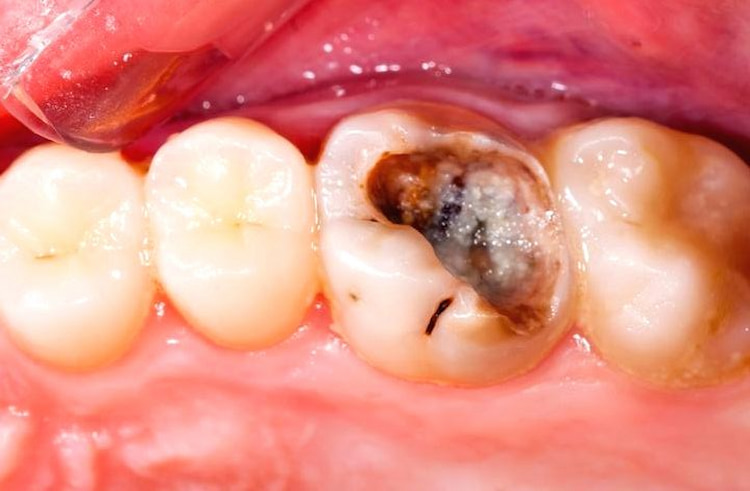Cavities, also called tooth decay, are holes in your teeth. They form when bacteria in plaque produce acids that erode tooth enamel. So, what does a cavity look like? Although they are a relatively common dental problem, you may not know what or how to detect them. Recognizing these visual signs of cavities can help you get the dental care you need so that your teeth always stay as healthy as possible.
In this blog, we will show you what cavities look like, how they develop, and ways to prevent or treat them.
What Do Cavities Look Like in Different Stages?
A cavity progresses through several distinct phases, each characterized by its own unique visual signs. When dental cavities first start, they may look like white spots. Over time, these spots become brown or black areas that eventually transform into holes in the tooth, requiring dental treatments, such as a dental filling. Diagnosis of these changes early can help to avoid further damage and enable early dental intervention.
Let’s check what a cavity looks like in different phases.
1. Early Decay or White Spots
The first sign of a cavity is a white spot on the tooth’s surface. These chalky white patches, especially visible on the front teeth, appear when minerals like calcium and phosphate begin to leach out of the enamel due to acid exposure (often from plaque buildup). At this stage, the enamel surface is still intact, and with proper care, such as fluoride treatment, improved oral hygiene, and reduced sugar intake, the damage can still be reversed before it turns into a cavity.

2. Enamel Decay
As the damage to tooth enamel extends, it breaks through just below the teeth, becoming a light brown and chalky design. It can also feel rougher than the rest of your enamel. A certified medical expert must remove the decay and make fillings in your tooth.

3. Dentin Decay
When decay sinks past the first layer of enamel, it begins to wear away dentin, the soft inner tooth material; cavities generally darken in color here. Most people are sensitive to sweet, hot, or cold food and drinks at this stage. We may use composite fillings or more extensive restorative work, such as inlays and crowns.

4. Pulp Damage
Tooth decay can penetrate a tooth’s nerve (pulp) without repair. Symptoms, such as a very painful, swollen area, can develop. By this point, the infection may permit a root canal treatment or tooth extraction.

How to Spot a Cavity
Catching a cavity early can help prevent huge problems with your teeth. Cavities can be very subtle in the beginning stages, so you need to know what signs and symptoms to look for. These signs range from visual indicators such as discolorations and notable cavities to sensory cues like more sensitivity or occasional pain. Knowing all of these can help you get timely dental treatment.
Visual Inspection of Cavities
You can sometimes spot early signs of tooth decay just by looking in the mirror. At first, cavities may appear as chalky white spots, a sign that the enamel is beginning to lose minerals. As decay progresses, these spots can turn light brown or dark brown and may form visible holes or pits on the surface of your teeth. If you notice any discoloration, rough spots, or visible damage, it’s best to book a dental appointment right away.
Sensory Cues of Dental Cavities
Cavities don’t always show obvious visual signs at first, but your mouth might still send warning signals. You may experience:
- Tooth sensitivity to hot, cold, or sweet foods and drinks
- A dull or sharp toothache, especially when biting or chewing
- Bad breath or an unpleasant taste in your mouth
- Rough or uneven textures when you run your tongue over your teeth
If you notice any of these symptoms, don’t ignore them; cavities can worsen quickly once the enamel is damaged. Your dentist can detect even the smallest cavities and recommend the best treatment to stop decay in its tracks.
How to Prevent Cavities
Cavities are preventable with good oral hygiene and healthy habits. Here are some effective ways suggested in an article published on NIDCR to keep your teeth strong and decay-free:
- Brush twice a day: Use fluoride toothpaste and a soft-bristled toothbrush to remove plaque and food particles from all tooth surfaces.
- Floss daily: Clean between your teeth to remove debris and bacteria that brushing alone can’t reach.
- Limit sugary and acidic foods: Reduce sweets, soda, and sticky snacks that feed cavity-causing bacteria.
- Drink plenty of water: Water helps wash away food particles and keeps your mouth hydrated to support saliva production.
- Use fluoride products: Fluoride strengthens enamel and helps reverse early signs of tooth decay.
- Eat a tooth-friendly diet: Include calcium-rich foods like dairy, nuts, and leafy greens to support strong teeth.
- Visit your dentist regularly: Professional cleanings and checkups every six months help catch potential problems early.
- Consider dental sealants: Your dentist can apply a protective coating to the chewing surfaces of back teeth to prevent decay.
Consistent care and mindful habits go a long way toward keeping your smile healthy for years to come.
Read more: How Often Should I Replace My Toothbrush for Optimal Oral Health?

Get Professional Help for Your Dental Cavities
If you’ve noticed white spots, tooth sensitivity, or any signs of a cavity, it’s best not to wait. At Langley Dental Group, our experienced team uses the latest technology to detect cavities early and provide gentle, effective treatment.
Book your appointment today and let us help you protect your teeth for years to come!
How to Treat Dental Cavities
Sometimes, cavities can still form even when we take excellent care of our mouths. When it does, the proper treatment depends on how severe the decay is. Immediate intervention for cavities is vital to prevent further complications and improve oral health. Maximizing treatment options based on the size and depth of a cavity.
1. Fluoride Treatment
If a cavity is caught early, fluoride can help restore the enamel before a hole forms. Dentists apply a stronger fluoride gel, foam, or varnish than what’s in regular toothpaste. This process helps rebuild minerals in your teeth and stops early decay.
2. Dental Fillings
Once a cavity has formed, a dentist removes the decayed area and fills the hole with materials like composite resin, silver amalgam, or porcelain. Fillings stop the decay from spreading and restore your tooth’s shape and strength.
At Langley Dental Group, we also offer tooth colored fillings to solve the aesthetic concerns of our patients.
Further Reading: Why Dental Fillings Are Essential for Maintaining Oral Health
3. Dental Crowns
If the cavity is large or your tooth is weak, your dentist may cover it with a dental crown, a custom-made cap that protects the tooth. Crowns are usually made of porcelain, metal, or a mix of both, and they look and feel like natural teeth.
4. Root Canal Treatment
When decay reaches the inner part of your tooth (the pulp), it can cause pain and infection. In a root canal, the dentist removes the infected pulp, cleans the inside of the tooth, and seals it. A crown is often placed afterward to strengthen the tooth.
Make sure you check out this article if you plan to get a root canal treatment: What Foods to Eat After Root Canal Therapy
5. Tooth Extractions
If a tooth is severely damaged and can’t be saved, it may need to be removed. After extraction, your dentist can replace the missing tooth with an implant, bridge, or denture to maintain your smile and prevent shifting.
You Spotted a Decayed Tooth? The Solution Is Here!
Knowing what a cavity looks like and how it develops can enable you to prevent and address dental issues. The best way to protect yourself against cavities is to maintain regular dental visits, brush and floss your teeth at least twice daily, and eat nutritious meals.
If you think this might apply to you and you are experiencing each dental problem, we’re here to help! Our team at Langley Dental Group offers professional help to repair the decayed teeth.
Langley Dental Group provides complete dental care and education for everyone seeking a healthier smile. Contact us today to schedule a visit or to learn more about our preventive and restorative services. We are looking forward to seeing you.
FAQ
-
How do I know if my tooth pain means I have a cavity?
Tooth pain isn’t always from a cavity, but if it worsens when you eat something sweet, hot, or cold, decay could be the cause. At Langley Dental Group, we use digital X-rays and advanced diagnostic tools to pinpoint the exact reason for your discomfort, whether it’s a cavity, enamel wear, or gum sensitivity.
-
Can early-stage cavities really heal on their own?
Yes, if caught early enough. White spots on your teeth are the first sign of enamel demineralization, and at this stage, fluoride treatments and good oral hygiene can reverse the damage.
-
What happens if I ignore a small cavity?
Small cavities can grow quickly, reaching the inner layers of your tooth and causing infection or pain. This can eventually lead to the need for a root canal or extraction.
-
Are cavity treatments painful?
Not at all. With modern dental technology and gentle numbing techniques, cavity treatments are more comfortable than ever. Our dentists at Langley Dental Group make sure you feel relaxed and pain-free throughout your visit.
Suggested article: Are Tooth Fillings Painful? -
How often should I visit the dentist to avoid cavities?
It’s best to schedule a checkup and cleaning every six months. This allows us to catch any early signs of decay, remove plaque buildup, and strengthen your enamel before problems start. Regular visits also make treatments faster, easier, and more affordable in the long run.
Have you ever noticed early signs of a cavity or had a treatment that surprised you with how easy it was? Share your experience or ask your questions in the comments below; our team is happy to help and answer anything about keeping your smile healthy!




